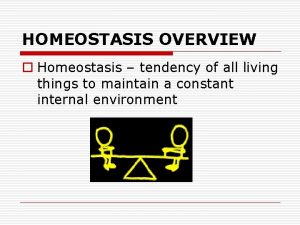Introduction to Homeostasis What is Homeostasis The tendency










- Slides: 10

Introduction to Homeostasis

What is Homeostasis? � The tendency of the body to maintain a relatively constant internal environment � Homeostasis is critical for survival. Humans (similar to other vertebrates) survive within a narrow range of (optimal) conditions � Analogy: think of what a car engine needs to function properly: it needs fuel, it needs to be an acceptable temperature, and sometimes parts need to be replaced.

What is Homeostasis? � When we talk about our “internal environment” in homeostasis, we are referring specifically to the extracellular fluid [ECF] (fluid outside our cells) � The ECF can change in volume, temperature, chemical composition, etc. � These changes are constantly monitored (by sensors in our body which ‘communicate’ with the brain) so that a constant level can be maintained.

Homeostasis Examples � As you move higher, you begin breathing more rapidly as the concentration of oxygen in the air begins to decrease. � You have been working very hard expending enormous amounts of energy driving one leg in front of the other, and you find your body seeming to crave food. � You feel your pulse and notice that your heart is beating more rapidly pumping blood through your body in an effort to supply your cells with more oxygen and energy from the food. All of these are ways of your body trying to achieve stability.

How Are Changes in the Body Monitored? MONITOR (sensors and receptors) – detect Changes in environment) Regulator (effectors) - receives Signals from control centre) Control Centre (mainly the hypothalamus or medulla oblongata) - sets a range of values within which variables should be maintained.

Feedback Mechanisms � Feedback ◦ Receptors in the body constantly monitoring your internal environment. ◦ Once a certain set point is reached, a message is sent to turn on or off pathway [temporarily]. � Positive Feedback ◦ Strengthens or increases a change in a variable � Negative feedback ◦ Reverses the change detected in a variable so that the variable is brought back within a normal range

Positive Feedback Example

Positive Feedback Example � What happens during child birth? � Monitor: the head of the baby pushes on the cervix � Control Centre: the hypothalamus (in the brain) processes this information, causing the release of oxytocin (hormone) � Effector: Oxytocin targets the uterus to contract more to help push the baby out � Result: the increase of one variable (pressure on the cervix) causes the increase of another variable (release of oxytocin hormone) which causes contractions to increase more

Negative Feedback Example

Negative Feedback Example � What happens when you are in a cold environment? � Monitor: thermoreceptors detect a decrease of temperature � Control Centre: the hypothalamus (in the brain) processes this information � Effector: Skeletal muscles contract, shivering generates energy production to increase temperature � Result: the decrease of one variable (external temp) causes the increase of another (body temp)



















